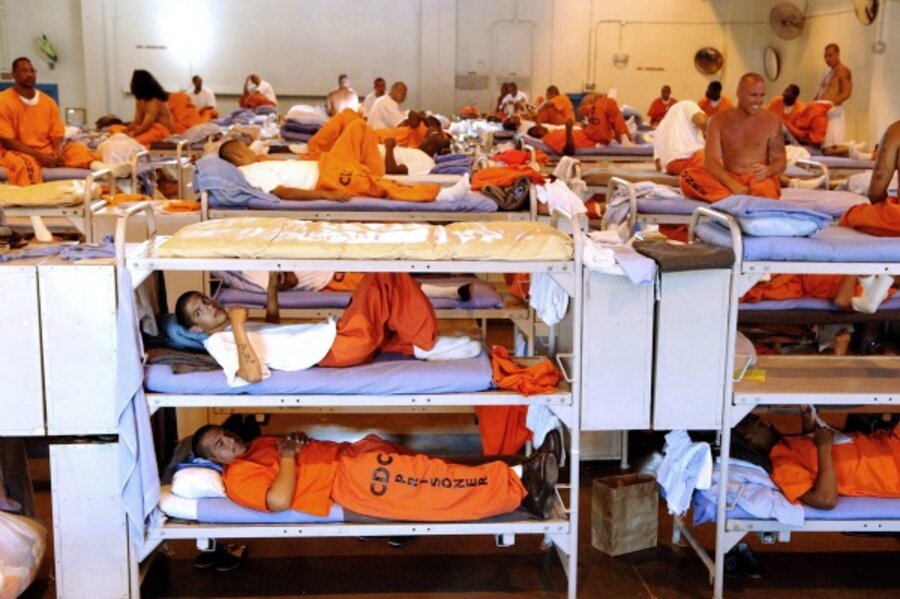Four ways to relieve overcrowded prisons
| Washington
Necessity can spur novelty. Even political novelty. As the need for fiscal austerity grows, an unlikely alliance has emerged between policymakers and public advocates who have long sought criminal justice reform. These policymakers are realizing what advocates have reiterated for years: The nation’s addiction to incarceration as a curb on crime must end. The evidence is staggering.
In California, 54 prisoners may share a single toilet and 200 prisoners may live in a gymnasium supervised by two or three officers. Suicidal inmates may be held for protracted periods in cages without toilets and the wait times for mental health care sometimes reach 12 months.
Citing these conditions and more, the Supreme Court ruled in May that California prisoners were deprived adequate access to medical and mental health care in violation of the Eighth Amendment and its prohibition against cruel and unusual punishment. It ordered the early release of tens of thousands of inmates.
Prison overcrowding is ubiquitous and shows few signs of abating: Between 1970 and 2005, the nation’s inmate population grew by 700 percent. Besides impeding access to health care, overcrowding also creates unsafe and unsanitary conditions, diverts prison resources away from education and social development, and forces low- and high-risk offenders to mingle, increasing the likelihood of recidivism.
Expect additional lawsuits. That’s why a consortium of states, including Illinois, Texas, and my home state of Virginia, submitted an amicus curiae or friend-of-the-court brief in support of the state of California.
America's overreliance on incarceration has also impeded the rights of criminal defendants. The Sixth Amendment guarantees legal representation to individuals charged with a crime. Yet, because of the crushing volume of cases, indigent defense programs often suffer from inadequate staffing, funding, and supervision.
In Kentucky, a public defender may represent more than 450 clients in a single year. In Miami, Florida, the annual case load is nearly 500 felonies and 2,225 misdemeanors. The consequences include wrongful incarceration, wrongful convictions, and guilty pleas when meritorious defenses are otherwise available.
Civil rights groups in Michigan and New York have already brought lawsuits seeking an overhaul of their states’ indigent defense systems. These lawsuits might be a harbinger for the future: States unfaithful to the promise of the Sixth Amendment may be forced to increase funding and restructure legislative priorities.
Protecting prisoners and criminal defendants is not just about fidelity to the Bill of Rights. It is about recognizing that they are acutely vulnerable because they do not have access to coalitions and political networks capable of effecting change. Affording them protection is consistent with the enduring constitutional principle that political democracy alone cannot adequately protect the rights of certain groups of people.
The solution?
First, revamp habitual-offender laws, now in effect in more than 20 states, which regularly yield perverse sentences.
California’s three-strikes law, for example, was passed during the paranoia that followed the searing murder of 12-year-old Polly Klaas by a long-time violent offender, and is so egregiously punitive that nonviolent petty theft may serve as a “third strike.” Leandro Andrade, a father of three, who never once committed a violent felony, received two sentences of 25 years-to-life for stealing children’s videotapes, including “Free Willy 2” and “Cinderella,” from Kmart. A new ballot initiative in California, “The Three Strikes Reform Act of 2012,” seeks to change this law.
Second, implement misdemeanor reform by decriminalizing offenses such as feeding the homeless, dog-leash violations, and occupying multiple seats on the subway. Such reform is vital: between 1972 and 2006, misdemeanor prosecutions rose from 5 million to 10.5 million.
Third, limit the use of pre-trial detention. Nearly two-thirds of the nation’s prison population haven’t been convicted of a crime - they are awaiting trial. Many are arrested for low-risk offenses such as disturbing the peace or traffic violations, and they languish in jail because they can’t afford bail. Releasing these individuals would not jeopardize public safety and would reduce overcrowding and public defender case loads. Just this year, Kentucky terminated pre-trial detention for numerous drug offenses and mandated citations rather than arrests for certain misdemeanors.
Fourth, impose nonprison penalties on those arrested for technical parole and probation violations like missing a meeting or court appearance. This would dramatically ameliorate overcrowding and excessive case loads given that over a third of all prison admissions are for such types of violations. Texas is leading the charge here, and through such measures has significantly reduced its inmate population.
The spirit that animates the Sixth and Eighth Amendments is human dignity. A recognition that no matter the crime or harm, criminal defendants and prisoners retain a dignity that must be respected.
Forty years ago, a group of inmates claimed they were deprived of this dignity and, in what has since become a subject of fascination in American pop culture, rioted at Attica Correctional Facility in New York. The ensuing violence and its death toll serves as an ominous reminder that America must pursue criminal justice reform if it is to honor this dignity.
Arjun Sethi is an attorney.
[Editor's note: An earlier reference incorrectly referred to the time of the Attica uprising.]





